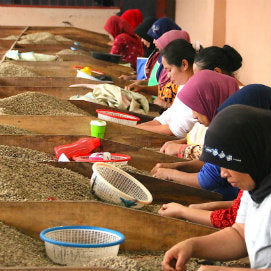THE ULTIMATE COFFEE JARGON GUIDE

The coffee industry, in particular the specialty coffee industry, seems to have developed it's every own vocabulary. The terms extend from the beverage itself - what's the difference between a latte and cappuccino; or the flavour and aroma compounds, of which there are thousands; the growing, harvesting, roasting process and the brewing process, it really is a completely different language.
So here it is, a blog to shine a little light on the complex coffee world for those of you who are starting out as a barista or an interested consumer.
FARMING AND PROCESSING
Coffee Cherry is the fruit from the coffee tree. Each coffee cherry has 2 seeds (or beans) inside of them, and it takes about 120 beans to brew a standard 8oz (230ml) cup. Harvesting coffee is very labour-intensive work. After picking the cherries from the tree the workers will sort through what they’ve picked and separate the unripe from the ripe ones. The ripe cherries are then packed and sent to the mill for processing.
When the cherries arrive at the mill, they are weighed and graded. Once they are graded and accounted for they get fed through the pulping and washing station.
The pulping machine removes the skin from the beans preparing them to be fermented or washed. The demucilager washes off the “fruit” around the seed known as mucilage. Once washed, the coffees get spread out onto concrete patios or raised beds, and turned over frequently to dry in the sun.
For a natural processed coffee, the fruit and skin is left on the beans, and are dried and fermented on the patios. When the coffee leaves the patio, it still has a layer of dried parchment surrounding the bean. The mill will hull the bean, de-stone the batch, and grade beans. For example, Ethiopia uses the Natural method.
Green coffee is the seed before it is roasted and after it is processed and dried. Roasters such as la Casa buy green beans either directly from the farm/estate or through a green bean distributor in bulk 30/60kg bags.
ROASTING, BLENDING AND TASTING
The roasting happens at a coffee roastery this is where the green beans are roasted and blended in order to get it ready for cafes and retail stores. It is a complex process with different levels of roast ie light, medium and dark.
In general, a light roast emphasises the acidity of the coffee, a medium roast develops sweetness, and a dark roast brings up the body, presuming these qualities are present in the bean to begin with.
Roast Profiling is used to allow the coffees own characteristics to highlighted.
Cupping is the coffee industry’s practice of observing the tastes and aromas of brewed coffee. The coffee taster attempts to measure aspects of the coffee's taste, such as aroma, body/mouthfeel, sweetness, acidity or brightness, flavour and aftertaste.
This process helps the roaster develop blends and single origins.
EQUIPMENT
Grinder is a device for crushing coffee beans into a grainy powder ready for tamping.
Hopper this the plastic cylinder on the top of the grinder where the beans go. Keep it filled with fresh coffee beans.
Tamping is the compacting of the ground coffee into the filterbasket of the portafilter prior to brewing to create a level solid puck for the espresso machine to extract an espresso.
Portafilter or Group Handle
The handle containing filter basket.
Filterbasket
Is a round, metal container that fits neatly into the portafilter. It has a perforated floor in which ground coffee is placed and tamped.
Group Head
Located on the front of a commercial espresso machine, with anywhere from one, two, three or four group heads per machine. The group head is a permanent attachment that brings heated water out of the machine and into the filter basket. Often referred to as the Group or Brew Group or Brew Head.
Steam Arm or Wand
The arm on an espresso machine that is used to heat and texturised milk. Pressurised steam is released from the boiler through the steam arm and nozzle. A technique used by the baristas to create a smooth creamy hot foamed milk.
TASTE
Crema
Crema is the creamy brown/golden foam found on the surface of a shot of espresso coffee. It should be golden to dark-tan in colour, a few millimetres in thickness and doesn't dissipate. The crema is a result of several factors in the brewing of the espresso, from the type of bean to the pressure employed by the espresso machine.
Body describes the physical properties – a sense of weight or heaviness in the mouth, or mouthfeel – of the coffee as it is being consumed.
Acidity this is generally described as a pleasing brightness or sharpness delivered from the fruits and floral notes in the coffee.
THE ESPRESSO BEVERAGES
Espresso comes in two sizes: single and double.
A single espresso is a 25-30ml espresso made from 12 grams (or 2 clicks of the grinder) of coffee; A double espresso is a 50-60ml espresso made from 21 grams (or 3 clicks of the grinder) of coffee.
Ristretto: is a very short espresso, consisting of only 20ml of coffee and will only take 20 seconds to pour. The espresso/short black forms the basis of all of
the following milk coffees:
Macchiato: served in a 90ml glass, the macchiato is a 25/30ml espresso with a dash of milk.
Piccolo latte: served in a 90ml glass, the piccolo is a 25/30ml espresso topped up with warm texturised milk.
Long Black: is a full cup of coffee, no milk. Pour the water first from the hot water outlet on the espresso machine, then add a double espresso shot on top. It will retain some crema but not as dense as a short black, and it will be ready to drink.
Cappuccino: is a single shot of espresso coffee and texturised milk in a 240ml cup with lots of foam and chocolate sprinkles.
Latte: served in a 220ml latte glass and made with a shot of espresso filled with texturised creamy milk.
Flat White: a single shot of espresso in a 240ml cup, topped with texturised milk, hold the foam.
There's a lot more but let's leave the rest for a rainy day :-)

